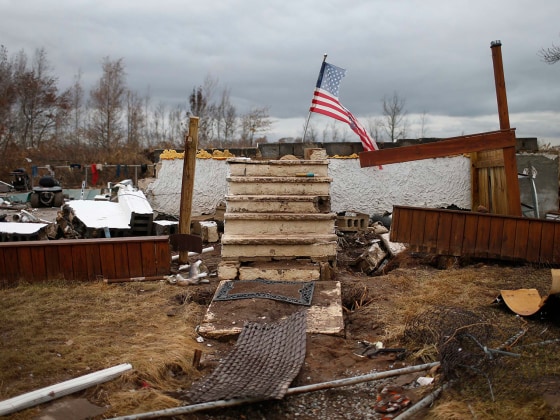

As many as a third of the people who were killed by Superstorm Sandy or its aftermath drowned, government health officials report. And nearly half of those who drowned had stayed behind despite evacuation orders, the team at the Centers for Disease Control and Prevention says.
That means government warnings for people to get out a full day before the storm hit either didn’t sink in, or people willfully ignored them, the CDC team said. There’s also an indication that some wanted to leave but couldn’t – something emergency planners need to take into consideration as the 2013 hurricane season approaches.
Hurricane Sandy hit the U.S. northeast on October 29, colliding with a winter storm to make a monumental tempest.
“Sandy’s tropical storm winds stretched over 900 miles, causing storm surges and destruction over a larger area than that affected by hurricanes with more intensity but narrower paths,” the CDC team, led by Michelle Murti, wrote in the agency’s weekly report on death, injury and illness.
Her team examined data on 117 of the deaths – media reports have the toll as high as 131 – to see how, when and where people died. They used the Red Cross reporting system, which collates data from sources such as funeral home directors, the Federal Emergency Management Agency (FEMA), hospitals, and news reports. Volunteers then questioned medical examiners, doctors, fire departments, police and families for more detail.
“Of the directly related deaths, the most common mechanism was drowning, followed by trauma from being crushed, cut, or struck,” the CDC team wrote. They found nearly 60 percent of the people killed directly by the storm itself drowned, and another 28 percent were crushed, hit or cut.
“Poisoning was the most common indirectly related cause of death; of the 10 poisonings, nine were caused by carbon monoxide. Most directly related deaths occurred during the first few days of the storm, whereas indirectly related deaths continued from the day before the storm into the middle of November.”
People can die from carbon monoxide poisoning as they use gas grills to cook indoors or use gas ovens or stoves for heat. Gasoline-powered generators can also produce the odorless, toxic gas and it can drift indoors if the generator is not vented properly.
More than half of those who drowned were in their own homes, the researchers found. “One person drowned in a flooded commercial building lobby, and another person drowned while intentionally swimming off a storm-affected beach,” they wrote.
Ninety percent of the New Yorkers who drowned had lived in the main evacuation zone, they said. “Notes written by Red Cross volunteers on these 20 deaths captured decedents’ reasons for not evacuating, such as ‘afraid of looters,’ ‘thought Hurricane Irene was mild,’ and ‘unable to leave because did not have transportation’.” Hurricane Irene had hit the region in August 2011.
Drowning had been the traditional cause of death from hurricanes, but by the 1970s, officials had good early warning and evacuation plans, the researchers noted.
“Since that time, hurricanes have had other leading causes of death, such as trauma for the Florida hurricanes in 2004 and 2005, and carbon monoxide poisoning for Hurricane Ike in 2008. However, drowning continues to be an important cause of death, and was the leading cause for Hurricane Katrina (2005) and Sandy,” they wrote.
“Given the inability and unwillingness of some residents to evacuate, additional research is needed to identify barriers and motivators for persons during an evacuation and the effectiveness of interventions designed to assist these persons.”
Related: